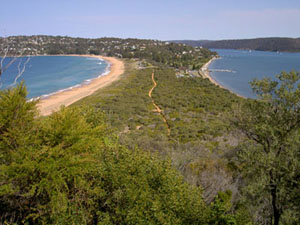 Palm Beach
Palm Beach 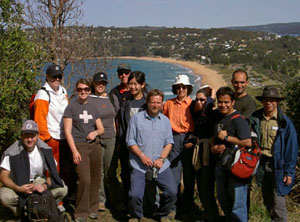 Pittwater Team
Pittwater TeamConservation Volunteers Australia offers a number of different volunteer opportunities from one day Better Earth local environmental projects through to two week expeditions to remote outback locations that provide an amazing working holiday experience.
My first experience as a volunteer happened on the 21st August 2004 when I participated in the Better Earth project at Pittwater, one of Sydney’s northern coastal areas. I was supposed to meet the team leader and other team members at 8am in the Sydney Central Train Station, under the “big clock”. Being relatively new to Sydney I was not absolutely sure where this “big clock” is. Anyway just to play safe I left early and arrived half an hour earlier. When I exited the platform area sure enough I saw a large clock overhead. I thought, “That was easy”. So I sat down close by and waited. Time went by and before long it was 5 minutes to 8am. I couldn’t see anyone that looked like a “volunteer”. Then it was 8am and still no one showed. I was starting to worry if they have cancelled the project. Luckily I had the leader’s mobile phone number. When I contacted the leader Carl I found out I was waiting under the wrong ”big clock”. It was supposed to be the “big clock tower” on the other side of the station. Anyway it was a happy ending. I met up with Carl and the others and we boarded a small van and headed out to Pittwater.
I was pleasantly surprised to find out our team consisted of a fantastic mix of people from all walks of life, including retirees, working people, university students and international travellers. It was a unique experience alone chatting to my fellow members. Time passed very quickly when you were having fun. Before we realised it the van stopped and we arrived at our destination. It looked like a beautiful place. Later I found out it was called Palm Beach, a famous summer beach resort.
 Palm Beach
Palm Beach  Pittwater Team
Pittwater Team
Our target site was along both sides of a walking track on top of the sand dune. The aim of our project was to remove exotic weeds around the native flora. Our target weed for the day was Asparagus Fern (Protasparagus aethiopicus).
“Hey, I know this plant. I used to grow it in my garden.”
Carl said: “That’s correct. But it is not a native plant. It was imported from South America as an ornamental plant. Unfortunately over the years it had escaped and infested the natural bushland especially along the coastal areas. The infestation was caused mainly by birds eating the red berries and dispersing the seeds and irresponsible dumping of garden refuse.”
After Carl showed us the enormousity of the infestation I was left me speechless! The first thing that came to my mind was “We must be crazy or stupid if we try to remove this weed by hand”. Luckily everyone else seemed to be keen and motivated. So I decided to go with the flow. May be there are miracles somewhere down the line.
Before we started working our team leader explained some of the Operational Health and Safety issues and pointed out some of the hazards we needed to be careful with. Then we were taught how to use the tools and shown how to remove the weed properly. After working for a little while and after speaking to some of the more experienced team members I started to realise it was not such a futile exercise after all. I began to understand how my small contribution fits into the big picture. Like a small ant, its contribution might seem small to the whole colony but it is nevertheless important and it does make a difference. As along as I am sincere and give it my best “shot”, I too can make a difference. My heart became more peaceful and I started to enjoy the work.
During lunchtime Carl took us for a hike to visit the famous and historic Barrenjoey Lighthouse at the end of Palm Beach. Volunteers were restoring the lighthouse and the living quarters to their original state. The view on top was just magnificent. We had our lunch while enjoying the beautiful Palm Beach, Pittwater Bay and the Ku Ring Gai National Park. We continued weeding after lunch, finished off at 3pm and got back to Sydney Central Station at about 4pm.
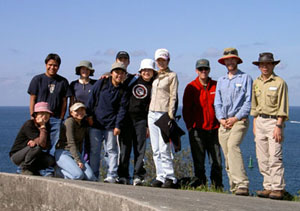 Middle Head Team
Middle Head Team 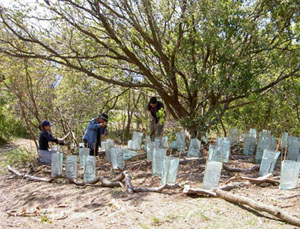 Revegetation
Revegetation
I participated in many Better Earth projects since. With these projects I was able to visit many beautiful places around Sydney. For example, Sydney Harbour National Park, Long Reef Headland, Bungan Beach, Yarra Beach etc. In most of these projects we had the opportunities to work with the local community and bushcare groups. We met people who still cared. That’s so important. And their impact is very significant. They could show us different methods they’d tried and those that had proven successful.
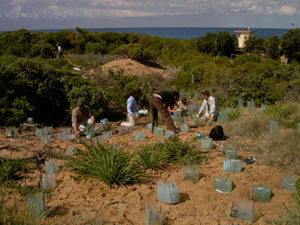 Revegatation on sand dune
Revegatation on sand dune 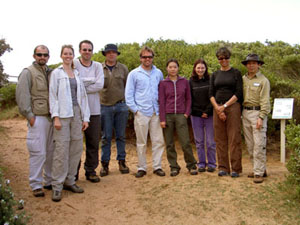 Long Reef Team
Long Reef Team
I really look forward to participating in the projects. It’s relaxing ... not as in being slack, but being out in the open and with people who share the same inspiration. I get a real kick out of it. I feel personally satisfied — knowing I’ve done a good days work. ”
Another little side benefit is, while you are volunteering you can achieve the Certificate in Active Volunteering. The Certificate in Active Volunteering is a formal qualification that recognises the competencies volunteers achieve through volunteering.